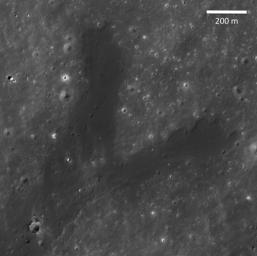
|
Forked Impact Melt Flows at Farside Crater
- Click the image above for a larger view
- Full-Res JPEG (508 x 507) (26.5 kB)
- Full-Res TIFF (508 x 507) (258.0 kB)
Caption:
Young, Copernican-aged lunar impact craters exhibit spectacular deposits of lava-like material produced by shock melting in and around the craters. These lunar impact melts are observed as thin, hard-rock veneers, flows, and ponds. This image highlights a spectacular example of a large impact melt flow that flowed from a young small highlands crater (~3.1 kilometers or ~2 miles in diameter). The distal portion of this curved impact melt flow splits into two separate flows. The source crater is 2.5 kilometers (1.5 miles) to the south in a region of the farside highlands ENE of Mare Moscoviense. Image width is 1.3 kilometers (1421 yards), and the pixel width is 1.25 meters (4 feet), NAC Image M112902715L, illumination is from the right.
Background Info:
NASA's Goddard Space Flight Center built and manages the mission for the Exploration Systems Mission Directorate at NASA Headquarters in Washington. The Lunar Reconnaissance Orbiter Camera was designed to acquire data for landing site certification and to conduct polar illumination studies and global mapping. Operated by Arizona State University, LROC consists of a pair of narrow-angle cameras (NAC) and a single wide-angle camera (WAC). The mission is expected to return over 70 terabytes of image data.
Cataloging Keywords:
| Name | Value | Additional Values |
|---|---|---|
| Target | Moon | |
| System | Earth | |
| Target Type | Satellite | |
| Mission | Lunar Reconnaissance Orbiter (LRO) | |
| Instrument Host | Lunar Reconnaissance Orbiter | |
| Host Type | Orbiter | |
| Instrument | Lunar Reconnaissance Orbiter Camera (NAC) | |
| Detector | Narrow Angle Camera (NAC), Wide Angle Camera (WAC) | |
| Extra Keywords | Crater, Grayscale, Impact | |
| Acquisition Date | ||
| Release Date | 2010-06-22 | |
| Date in Caption | ||
| Image Credit | NASA/GSFC/Arizona State University | |
| Source | photojournal.jpl.nasa.gov/catalog/PIA13226 | |
| Identifier | PIA13226 | |
